- MOE
- National Parks of Japan
- Ogasawara National Park
- Characteristics
main body

Characteristics
Subtropical Oceanic Island A Gold Mine of Evolution and Endemic Species
Date of Designation: October 16, 1972
Area: 6,629 ha (land area)
Related Prefecture: Tokyo
Area: 6,629 ha (land area)
Related Prefecture: Tokyo
Ogasawara National Park consists of subtropical islands located about 1,000 km south of the Japanese archipelago. These islands are oceanic islands that have never been connected to the mainland and thus uniquely evolved flora, fauna, and ecosystems can be found on the islands. Thanks to these advantages, Ogasawara National Park was registered as a World Heritage site in June 2011. The landscapes include the island landscapes unique to subtropical oceanic islands, pillow lava, and unique coastal landforms and one of the few submergence karst landforms in Japan. In addition, the marine mammals typified by humpback whales and dolphins, green turtles, coral reefs, and tropical fish create underwater landscapes. For the use of the park, the park is also known for its advanced eco-tourism centering on the council of Ogasawara Eco-Tourism, which is represented by the establishment of independent rules for whale watching as the start of Japan's eco-tourism field.
Terrain/ Scenery
Formation of the Ogasawara Islands
The Ogasawara Islands are valuable because of the history of the birth and growth of islands by oceanic plates colliding.
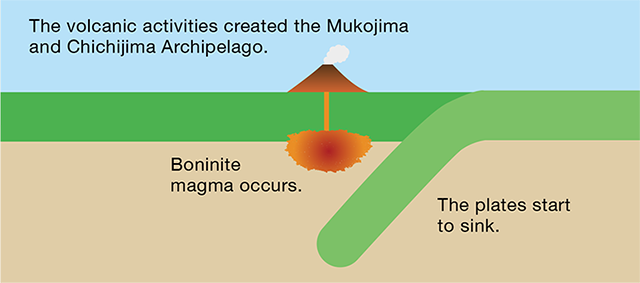
The volcanic activities created the Muko-jima and Chichi-jima Island s Archipelago.
Boninite magma occurs.
The plates start to sink.
About 48 million years ago, volcanic activity just beneath the plate created the Chichi-jima and Muko-jima Islands Archipelago.
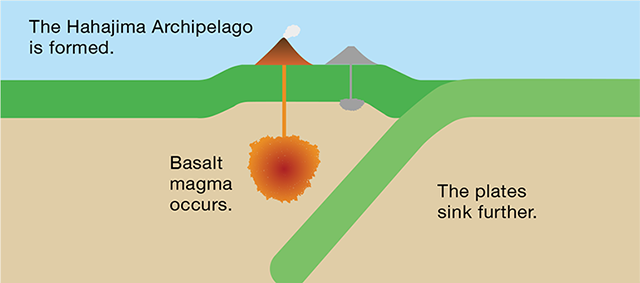
The Haha-jima Island Archipelago is formed.
Basalt magma occurs.
The plates start to sink.
The Haha-jima Islands Archipelago formed after volcanic activity at a deeper site about 44 million years ago.
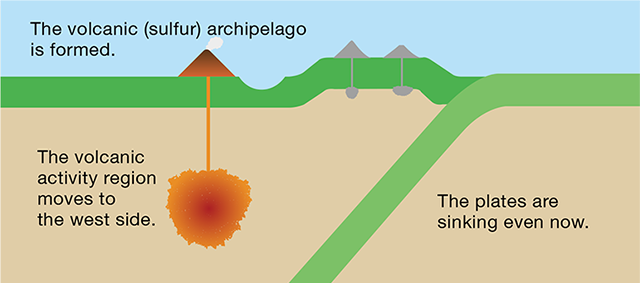
The volcanic (sulfur) archipelago is formed.
The volcanic activity region moves to the west side.
The plates are sinking even now.
The subduction of the plate advanced, forming a chain of volcanic islands that are active even today.

Pillow lava Including Boninite
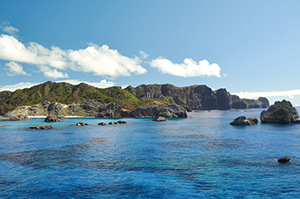
Submergence Karst on the Periphery of the Minami-jima Island
Visitors can observe piles of pillow lava that formed after magma solidified during past submarine volcanic activity, and boninite, which was named after the western name of the Ogasawara Islands, the Bonin Islands, the uguisu-zuna (uguisu-sand) that formed from hard mineralsin the boninite, submergence karst, in which a karst landform formed through the erosion and weathering of limestone and other unique geographical features rare in the world.
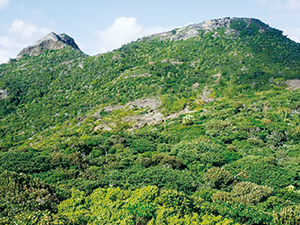
Dry Scrub Forest (Anijima Island)
Landscapes and Ecosystems
A forest of short trees called a dry scrub forest is widely distributed across Chichi-jima Island and Anijima Island. Endemic species that evolved by changing the shape of leaves in the dry climate of the Chichi-jima Island and Anijima Island can be found in the dry scrub forests.
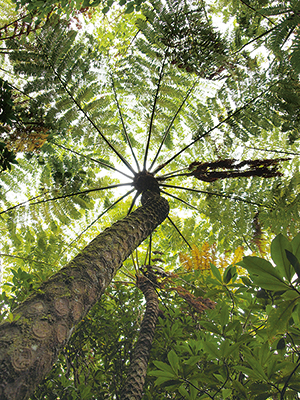
Tree Ferns Grown in a Hydrarch Tall Tree Forest (Sekimon)
Haha-jima Island, on the other hand, boasts a wide distribution of tall trees that prefer high humidity and rain, called a hydrarch tall tree forest.
Owing to the fact that living creatures cannot travel across land to migrate from the oceanic islands such as the Ogasawara Islands, only a limited number of living creatures that were able to travel across the sky and ocean found their way to the island. Over time, the living creatures that became comfortable in the environment on the islands survived and uniquely evolved to further adapt to the environment.
As a result of the unique evolution, the Ogasawara Islands became home to a number of endemic species that are only found on the small islands. The islands boast a high percentage of endemic species among all endemic species, which are 36% for plants (vascular plants), 28% for insects, and 94% for land snails.
As a result of the unique evolution, the Ogasawara Islands became home to a number of endemic species that are only found on the small islands. The islands boast a high percentage of endemic species among all endemic species, which are 36% for plants (vascular plants), 28% for insects, and 94% for land snails.
Plants
Situated in a warm subtropical zone, Ogasawara is home to the subtropical species Schima mertensiana, the Japan mainland species Stachyurus macrocarpus, the Oceanian species Clinostigma savoryana, and other plants of diverse origin. In addition, as a result of unique species differentiation, the Ogasawara Islands are home to numerous species and boasts a high proportion of endemic species even though they are small oceanic islands.
Wildlife
As for animals, Columba janthina nitens, Pteropus pselaphon, and other animals requiring preservation due to the fact that they only make their habitats on Ogasawara in small number.
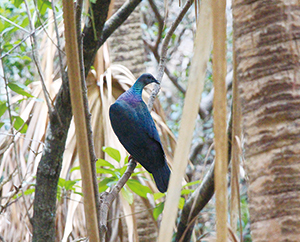
Columba janthina nitens (Endemic species)
In addition, the periphery of the Ogasawara Islands is home to a number of dolphins and whales, as well as Japan's largest spawning region for green turtles, making it a marine observation spot for a variety of living creatures.
